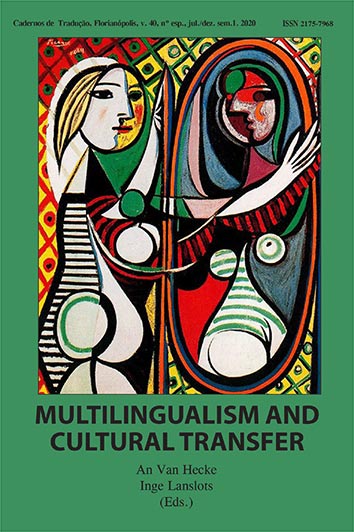Framing US-Mexican Borderlands: Phillip Rodriguez' visual aesthetics
DOI:
https://doi.org/10.5007/2175-7968.2020v40nespp157Abstract
The US–Mexican border towns are often defined as both multicultural and relatively young transnational cities, which have grown apart despite their common historical past. The border policy, which actually started during Eisenhower’s administration, seems to favor further differences. Border towns as well as the identity (construction) of their inhabitants – whether they are in passing or not – now seem to change more drastically. The present article analyzes how documentary film-maker Phillip Rodriguez translates urban imagery and ethnographic shifts to the screen, in particular in Mixed Feelings: San Diego/Tijuana (2002) and Los Angeles Now (2003). Close attention will be paid to multimodal strategies and other discursive practices, as well as to the dominant use of English language and the somehow biased focus on the social actors involved in the border zone. We argue that, in his portrayal of border towns, Rodriguez invites his audience to consider border towns from a mainly northern perspective, aiming to represent multilayered and connected worlds, while visualizing dual and divided spaces. We thus seek to answer the question to which extent this discourse on border towns enriches the larger socio-cultural polysystem in terms of transmission of knowledge and affects related to living experiences in urban borderlands.
Literaturhinweise
Amilhat Szary, Anne-Laure; Giraut, Frédéric. (Eds.). Borderities and the politics of contemporary mobile borders. London: Palgrave Macmillan, 2015.
Cruz,Teddy ; Forman,Fonna . Avaible to:http://estudioteddycruz.com/. Access:04 February 2020.
Dear, Michael. Why Walls Won’t Work. Repairing the U.S.-Mexico Divide. Oxford University Press, 2015.
Dell’Agnese, Elena. “‘Welcome to Tijuana’: Popular Music on the US-Mexico Border”. Geopolitics. vol. 20, nº.1, (2015): 171-192. Avaible to: https://doiorg.kuleuven.ezproxy.kuleuven.be/10.1080/14650045.2014.979914. Access in: 12/12/2019.
Funari, Vicky; De La Torre, Sergio. Maquilapolis. City of Factories. San
Francisco: Independent Television Service, 2006.
Gramling, David. The Invention of Monolingualism. Sydney: Bloomsbury Academic, 2016.
Herzog, Lawrence A. “Cross-national Urban Structure in the Era of Global Cities: The US-Mexico Transfrontier Metropolis”. Urban Studies. vol. 28, nº.4, (1991): 519-533.
Herzog, Lawrence A. “USA-Mexico Border Cities: a Clash of Two Cultures”. Habitat International. vol. 15, nº. 1-2, (1991): 261-273.
Herzog, Lawrence A. “The Transfrontier Metropolis”. Harvard Design
Magazine. nº.1, 1997. Avaible to: http://www.harvarddesignmagazine.org/issues/1/the-transfrontier-metropolis. Access in: 05 February 2020.
Herzog, Lawrence A. “Cross-national Urban Structure in the Era of Global Cities: The US-Mexico Transfrontier Metropolis”. Urban Studies. vol. 28, nº.4, (1991): 519-533.
Herzog, Lawrence A; Sohn, Christophe. “The Cross-Border Metropolis in a Global Age: A Conceptual Model and Empirical Evidence from the US-Mexico and European Border Regions”. Global Society. vol. 28, nº. 4, (2014): 441-461.
Herzog, Lawrence A; Sohn, Christophe. “The Co-mingling of Bordering
Dynamics in the San Diego-Tijuana Cross-border Metropolis”. LISER Working Papers. nº. 1, (2016): 1-19.
House, John W. Frontier on the Rio Grande. Oxford: Clarendon Press, 1982.
Lanslots, Inge; Van Hecke, An. “Bridging the gaps in Southern California: Multicultural spaces throughout the works of Alejandro Morales”. Transnationalism(s), edited by Dagmar Vandebosh and Theo D’haen, Amsterdan: BRILL/RODOPI, 2018, p. 192-204.
Los Angeles Now. Directed by Phillip Rodriguez, City Projects, 2004.
Lynch, Kevin; Appleyard, Donald.“Temporary Paradise? A Look at the Special Landscape of the San Diego Region.” Report to the City of San Diego, 1974.
Mancha, Luis. Inner Borderlines. Visions of America through the Eyes of Alejandro Morales. Films Media Group, 2014.
Mezzadra, Sandro; Neilson, Brett. Border as Method, or, the Multiplication of Labor. Durham: Duke university press, 2013.
Mixed Feelings: San Diego/Tijuana. Directed by Phillip Rodriguez, City Projects, 2002.
Nichols, Bill. Introduction to Documentary. Indiana: Indiana University Press, 2001.
Simon, Sherry. “The City in Translation: Urban Cultures of Central Europe”. Target. vol. 24, nº.1, (2012): 126-140.
Soja, Edward W. Postmetropolis: Critical Studies of Cities and Regions. Oxônia: Blackwell, 2000.
Staudt, Kathleen. “The Border, Performed in Films: Produced in both Mexico and the US to ‘Bring Out the Worst in a Country’”. Journal of Borderlands Studies. vol. 29, nº. 4, (2014): 465-479.
Rodriguez, Phillip. Avaible to: https://www.philliprodriguez.co/. Access in: 04 February 2020.
The Wall. Directed by Brian Kaufman, USA TODAY Network, 2018.
Welcome to Tijuana. Directed by Joerg Steineck, Journeyman Pictures, 2009.
Downloads
Veröffentlicht
Zitationsvorschlag
Ausgabe
Rubrik
Lizenz
Autores têm autorização para assumir contratos adicionais separadamente, para distribuição não exclusiva da versão do trabalho publicada nesta revista (ex.: publicar em repositório institucional ou como capítulo de livro, com reconhecimento de autoria e publicação inicial nesta revista).





















































